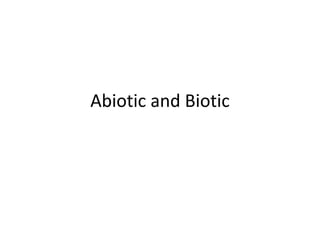Abiotic or Biotic factors
•Descargar como PPTX, PDF•
2 recomendaciones•8,247 vistas
Denunciar
Compartir
Denunciar
Compartir

Recomendados
Recomendados
Más contenido relacionado
La actualidad más candente
La actualidad más candente (20)
Energy Flow in Environment : Ecological Energetics

Energy Flow in Environment : Ecological Energetics
Similar a Abiotic or Biotic factors
Similar a Abiotic or Biotic factors (20)
Más de Rick Turner
Más de Rick Turner (20)
Abiotic or Biotic factors
- 2. Ecosystems • Interacting populations of organisms with biotic and abiotic factors
- 3. Abiotic Factors • Non-living factors that affect the ecosystem: light, space, temperature, shelter, water, soil composition
- 4. Biotic Factor • Living factors that affect the ecosystem: food sources, other population members, other species
- 5. Competition • More than one individual, or population in an ecosystem, relies upon the same limited resources
- 6. Niche • Role in an ecosystem
- 7. Limiting Factor • A biotic or abiotic factor needed as a resource for survival; depletion prevents growth or expansion of the organism or population
- 8. Summary • Resources for an organism’s habitat, including space, food, shelter, and water, may be limited or depleted by competition. Two species cannot operate in the same niche in the same environment. • Organisms rely on natural resources in their environment such as quantity of light, water supply, and suitable temperature. • Competition occurs when niches overlap and organisms seek the same resources, especially when the population density is high.